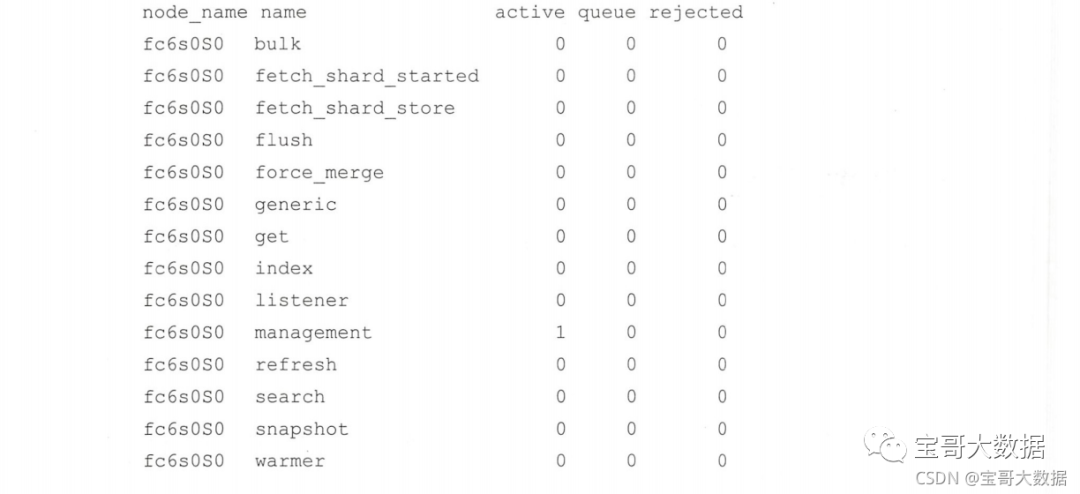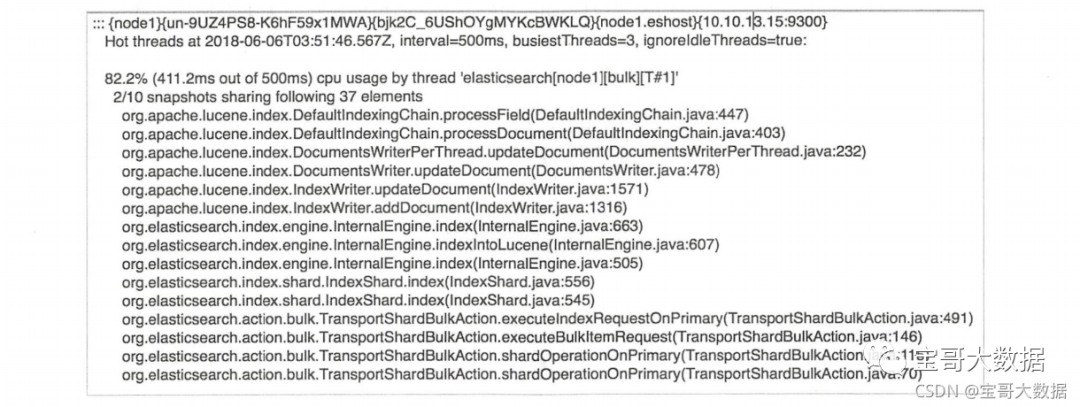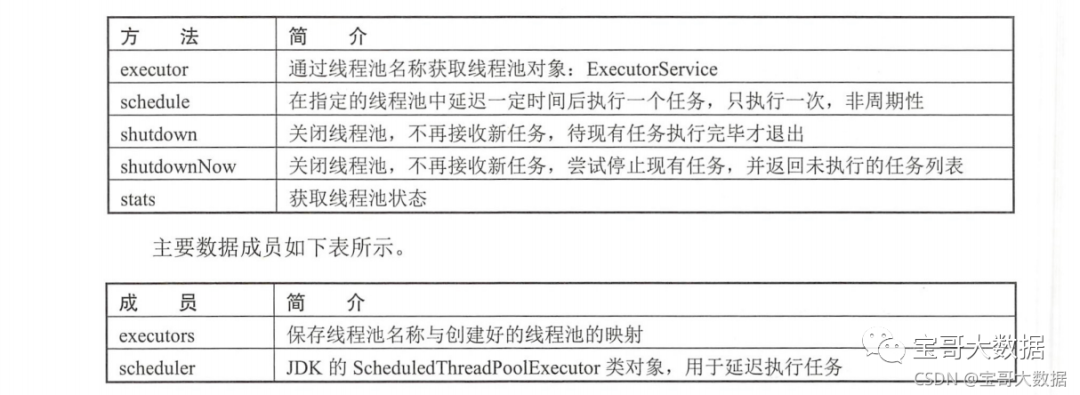文章目录
一、简介
每个节点都会创建一系列的线程池来执行任务,许多线程池都有与其相关任务队列,用来允许挂起请求,而不是丢弃它。 下面列出目前ES版本中的线程池。
官网: https://www.elastic.co/guide/en/elasticsearch/reference/current/modules-threadpool.html
generic
:用于通用的操作(例如,节点发现),线程池类型为 scaling。index
:用于index/delete操作,线程池类型为fixed,大小为处理器的数量,队列大小为200,允许设置的最大线程数为1+处理器数量。search
:用于count/search/suggest操作。线程池类型为fixed, 大小为int((处理器数量3)/2)+1,队列大小为1000。get
:用于get操作。线程池类型为fixed, 大小为处理器的数量,队列大小为1000。bulk
:用于bulk操作,线程池类型为fixed,大小为处理器的数量,队列大小为200,该线程池允许设置的最大线程数为1+处理器数量。snapshot
:用于snaphostrestore操作。线程池类型为scaling,线程保持存活时间为5min,最大线程数为min(5, (处理器数量)/2)。warme
:用于segment warm-up操作。线程池类型为scaling, 线程保持存活时间为5min,最大线程数为min(5, (处理器数量)/2)。refresh
:用于refresh 操作。线程池类型为scaling, 线程空闲保持存活时间为5min,最大线程数为min(10, (处理器数量)/2)。listener
:主要用于Java客户端线程监听器被设置为true时执行动作。线程池类型为scaling,最大线程数为min(10, (处理器数量)/2)。same
:在调用者线程执行,不转移到新的线程池。management
:管理工作的线程池,例如,Node info、Node tats、 List tasks等。flush
:用于索引数据的flush操作。force_merge
:顾名思义,用于Lucene分段的force merge。fetch_shard_started
:用于TransportNodesAction.fetch_shard_store
:用于TransportNodesListShardStoreMetaData。thread_pool.search.size: 30
:线程池和队列的大小可以通过配置文件进行调整,例如,为search增加线程数和队列大小:
二、线程池类型
如同任何要并发处理任务的服务程序一样,线程池要处理的任务类型大致可以分为两类:CPU计算密集型和I/O密集型。对于两种不同的任务类型,需要为线程池设置不同的线程数量。
一般说来,线程池的大小可以参考如下设置,其中N为CPU的个数:
对于CPU密集型任务,线程池大小设置为N+1; 对于I/O密集型任务,线程池大小设置为2N+1;
对于计算密集型任务,线程池的线程数量 一 般不应该超过N+1。如果线程数量太多,则会导致更高的线程间上下文切换的代价。加1是为了当计算线程出现偶尔的故障,或者偶尔的I/O、发送数据、写日志等情况时,这个额外的线程可以保证CPU时钟周期不被浪费。
I/O密集型任务的线程数可以稍大一些,因为I/O密集型任务大部分时间阻塞在I/O过程,适当增加线程数可以增加并发处理能力。而上下文切换的代价相对来说已经不那么敏感。但是线程数量不一定设置为2N+1,具体需要看I/O等待时间有多长。等待时间越长,需要越多的线程,等待时间越少,需要越少的线程。因此也可以参考下面的公式:
最佳线程数= ((线程等待时间 + 线程CPU时间) 线程CPU时间) * CPU数
为了应对这两种类型的任务,ES封装了以下类型的线程池。
2.1、fixed
线程池拥有固定数量的线程来处理请求,当线程空闲时不会销毁,当所有线程都繁忙时,请求被添加到队列中。
size
参数用来控制线程的数量。queue_size
参数用来控制线程池相关的任务队列大小。设置为-1表示无限制。当请求到达时,如果队列已满,则请求将被拒绝。
例如:
thread_pool.search.size: 30
thread_pool.search.queue_size: 1500
2.2、scaling
scaling 线程池的线程数量是动态的,介于core和max参数之间变化。线程池的最小线程数为配置的core大小,随着请求的增加,当core数量的线程全都繁忙时,线程数逐渐增大到max数量。max是线程池可拥有的线程数.上限。当线程空闲时,线程数从max大小逐渐降低到core大小。
keep_alive
参数用来控制线程在线程池中的最长空闲时间。
例如:
thread_pool.warmer.core: 1
thread_pool.warmer.max:8
thread_pool.warmer.keep_alive: 2m
2.3、direct
这种线程池对用户并不可见,当某个任务不需要在独立的线程执行,又想被线程池管理时,于是诞生了这种特殊类型的线程池:在调用者线程中执行任务。
2.4、fixed_auto_queue_size
与fixed类型的线程池相似,该线程池的线程数量为固定值,但是队列类型不一样。 其队列大小根据利特尔法则( Little's Law) 自动调整大小。该法则的详细信息可以参考https://en.wikipedia.org/wiki/Little%27s_law。 该线程池有以下参数可以调整:
size
:用于指定线程数量;queue_size
,:指定初始队列大小; .min_queue_size
:最小队列大小;max_queue_size
:最大队列大小;auto_gueue_frame_size
: 调整队列之前进行测量的操作数;target_response_time
:一个时间值设置,用来指示任务的平均响应时间,如果任务经常高于这个时间,则线程池队列将被调小,以便拒绝任务。
该线程类型为实验性质,未来可能会移除。目前只有search线程池使用这种类型。( Deprecated in 7.7.0 and will be removed in 8.0. )
三、处理器设置
https://www.elastic.co/guide/en/elasticsearch/reference/current/modules-threadpool.html#node.processors
默认情况下,ES自动探测处理器数量。各个线程池的大小基于这个数量进行初始化。在某些情况下,如果想手工指定处理器数量,则可以通过设置 processors 参数实现:
processors: 2
有以下几种场景是需要明确设置processors数量的:
(1)、在同一台主机上运行多个ES实例,但希望每个实例的线程池只根据一部分CPU来设置,此时可以通过processors参数来设置处理器数量。例如,在16核的服务器上运行2个实例,可以将processors设置为8。请注意,在单台主机上运行多个实例,除了设置processors数量,还有许多更复杂的参数需要设置。例如,修改GC线程数,绑定进程到CPU等。
(2)、有时候自动探测出的处理器数量是错误的,在这种情况下,需要明确设置处理器数量。要检查自动探测的处理器数量,可以使用节点信息API中的os字段来查看。
四、查看线程池
ES提供了丰富的API查看线程池状态,在监控节点健康、排查问题时非常有用。
4.1、cat thread pool
该命令显示每个节点的线程池统计信息。默认情况下,所有线程池都返回活动、队列和被拒绝的统计信息。我们需要特别留意被拒接的信息,例如,bulk 请求被拒绝意味着客户端写入失败。在正常情况下客户端应该捕获这种错误(错误码429)并延迟重试,但有时客户端不一定对这种错误做了处理,导致写入集群的数据量低于预期值。
curl -X GET "localhost:9200/_cat/thread_pool"
返回信息如下:

active 表示当前正在执行任务的线程数量 queue 表示队列中等待处理的请求数量 rejected 表示由于队列已满,请求被拒绝的次数。
对返回结果进行过滤等更多用法可参考官方手册: https://www.elastic.co/guide/en/elasticsearch/reference/6.1/cat-thread-pool.html。
4.2、nodes info
节点信息API可以返回每个线程池的类型和配置信息,例如,线程数量、队列大小等。下面的第一条命令返回所有节点的信息,第二条命令返回特定节点的信息。.
curl -X GET "localhost:9200/_nodes"
curl -X GET "localhost:9200/_nodes/nodeId1, nodeId2"
节点信息API返回的信息非常大,其中与线程池相关信息在thread_ pool 字段中,选取部分信息如下:
"thread_pool" : {
"force_merge" : {
"type" : "fixed",
"min" : 1,
"max" : 1,
"queue_size" : - 1
},
"fetch_shard started" : {
"type" : "scaling",
"min" : 1,
"max" : 16,
"keep_alive" : "5m",
"queue_size" : -1
}
}
该命令的完整信息可参考官方手册: https://www.elastic.co/guide/en/elasticsearch/reference/6.1/cluster-nodes-info.html
4.3、nodes stats
statsAPI返回集群中一个或全部节点的统计数据。
下面的第一条命令返回所有节点的统计数据,第二条命令返回特定节点的统计数据。
curl -X GET "localhost:9200/_nodes/stats" curl -X GET "localhost:9200/_nodes/nodeId1, nodeId2/stats"
默认情况下,该API返回全部 indices、oS、process、jvm、transport、http、fs、breaker 和thread_pool 方面的统计数据。其中线程池相关的返回结果摘要如下:
"thread_pool" : {
"bulk" : {
"threads" : 0,
"queue" : 0,
"active" : 0,
"rejected" : 0,
"largest" : 0,
"completed" : 0
}
}
该命令的完整使用方式可参考官方手册: https://www.elastic.co/guide/en/elasticsearch/reference/6.1/cluster-nodes-stats.html。
4.4、nodes hot threads
该API返回集群中一个或全部节点的热点线程。
当发现节点进程占用CPU非常高时,想知道是哪些线程导致的,这些线程具体在执行什么操作,常规做法是通过top命令配合jstack来定位线程,现在ES提供了更便捷的方式,通过hot threads API可以直接返回这些信息。
下面的第一条命令返回所有节点的热点线程,第二条命令返回特定节点的热点线程。
curl -X GET "localhost:9200/_nodes/hot_threads"
curl -X GET "localhost:9200/nodes/nodeId1, nodeId2/hot_threads"
该命令支持以下参数:
threads
:返回的热点线程数,默认为3。interval:ES
对线程做两次检查,来计算某个操作.上花费时间的百分比,此参数定义这个间隔时间。默认为500 ms。type
:定义要检查的线程状态类型,默认为CPU.API可以检查线程的CPU占用时间、阻塞(block)时间和等待(wait) 时间。ignore_idle_threads
:如果设置为true, 则空闲线程(例如,在套接字中等待,或者从空队列中获取任务)将被过滤。默认值为true。
其返回信息的样例如下图所示。

返回信息中的第一行表明这个是哪个节点的信息,以及这个节点的IP地址等。
::: {node1} {un- 9UZ4PS8-K6hF59x1MWA} {bjk2C_ _6USh0YgMYKcBWKLQ} {node1.eshost}
{10.10.13.15:9300}
接下来列出哪个线程占用较多的CPU,以及CPU的占用比:
82.2% (411.2ms out of 500ms) cpu usage by thread 'elasticsearch [node1]
[bulk] [T#1] '
最后是该线程的堆栈信息。
ES中的线程池是基于对Java线程池的封装和扩展。我们先看一下Java线程池的结构和使用方式,这些是ES内部线程原理的基础知识。
4.5、Java 的线程池结构
Java内部的线程池称为Executor框架,几个基本的类概念如下:
Runable定义一个要执行的任务。 Executor提供了execute 方法,接受一个Runable实例,用来执行一个任务。 ExecutorService是线程池的虚基类,继承自Executor, 提供了shutdown, shutdownNow等关闭线程池接口。 ThreadPoolExecutor线程池的具体实现。继承自ExecutorService,维护线程创建、线程生命周期、任务队列等。 EsThreadPoolExecutor是ES对ThreadPoolExecutor的扩展实现。未来会增加一些统计信息。
这几个类的继承结构如下图所示。

我们以一个简单的例子来看看Java 线程池的用法,ExecutorService 类用于保存创建的线程池实例,后续调用execute方法执行任务。在下面的例子中,任务类TestRunnable只是打印当前线程名称。
import java. util.concurrent.ExecutorService;
import java. util.concurrent.Executors;
public class ThreadPoolDemo {
public static void main(String[] args) {
//通过Executors构建一个固定大小的线程池,线程数量为2,返回线程池实例
ExecutorService executorService = Executors.newFixedThreadPool (2) ;
//调用 线程池的execute方法执行一个任务
executorService.execute(new TestRunnable());
}
}
class TestRunnable implements Runnable {
public void run() {
System.out.println (Thread.currentThread().getName()) ;
}
}
ES内部创建线程池时,返回类型同样是ExecutorService类。接下来我们通过构建过程来看看ThreadPoolExecutor的结构,其构造函数如下:
public ThreadPoolExecutor (int corePoolSize,
int maximumPoolSize,
long keepAl iveTime,
TimeUnit unit,
BlockingQueue<Runnable> workQueue,
ThreadFactory threadFactory,
RejectedExecutionHandler handler) {
if (corePoolSize < 0 || max.imumPoolSize <= 0 ||
maximumPoolSize < corePoolSize ||
keepAliveTime < 0)
throw new IllegalArgumentException() ;
if (workQueue == null || threadFactory == null || handler == null)
throw new Nul lPointerException() ;
this.corePoolSize = corePoolSize;
this.maximumPoolSize = maximumPoolSize;
this.workQueue = workQueue ;
this.keepAliveTime = unit.toNanos (keepAliveTime) ;
this.threadFactory = threadFactory;
this.handler = handler;
}
几个重要参数的含义如下:
corePoolSize
:线程池大小;maximumPoolSize
:最大线程数量;keepAliveTime
:线程空闲回收时间;BlockingQueue
:任务队列;handler
: 队列满,拒绝请求时的回调函数。
ThreadPoolExecutor类是Java线程池的具体实现,是整个线程池中最重要的类,ES 基于这个类进行了一些扩展。
五、ES的线程池实现
**ES中使用的线程池绝大部分封装在ThreadPool类中,**个别独立线程池的实现在本章末尾讨论。除了个别情况,在ThreadPool类中,会创建各个模块要使用的全部线程池。本章开始所讨论的几种线程池就是在ThreadPool类中创建的。
ThreadPool类创建各个线程池,要使用线程池的各个内部模块会引用ThreadPool类对象,通过其对外提供executor方法,根据线程池名称获取对应的线程池引用,进而执行某个任务。
ThreadPool对外提供的重要方法如下表所示。

当某个模块要在新的线程中启动任务时,典型的使用方式如下:
threadPool.executor(ThreadPool.Names.SNAPSHOT).execute(() ->
beginSnapshot (newState, newSnapshot, request.partial(), listener));
threadPool.executor方法返回snapshot线程池( ExecutorService类)的引用,通过线程池的execute方法执行任务,在本例中,任务的Runnable是Lambda表达式定义的。
5.1、ThreadPool 类结构与初始化
ThreadPool类对象在节点启动时初始化,在Node类的构造函数中初始化ThreadPool类:
final ThreadPool threadPool = new ThreadPool (settings, executorBuilders.toArray (new ExecutorBuilder[0]));
线程池对象构建完毕,将这个类的引用传递给其他要使用线程池的模块:
final ResourcewatcherService resourceWatcherService = new ResourceWatcherService (settings, threadPool);
线程池的名称在内部类Names中,最好记住它们的名字,有时需要通过jstack查看堆栈,ES的堆栈非常长,这就需要通过线程池的名称去查找关注的内容。
public static class Names {
public static final String SAME = "same";
public static final String GENERIC = "generic";
public static final String LISTENER = "listener";
public static final String GET = "get";
public static final String INDEX = "index" ;
public static final String BULK = "bulk";
public static final String SEARCH = "search";
public static final String MANAGEMENT = "management" ;
public static final String FLUSH = "flush";
public static final String REFRESH = "refresh";
public static final String WARMER = "warmer" ;
public static final String SNAPSHOT = "snapshot";
public static final String FORCE MERGE = "force_merge";
public static final String FETCH\_SHARD\_STARTED = "fetch\_shard\_started";
public static final String FETCH\_SHARD\_STORE = "fetch\_shard\_store";
}
线程池类型由枚举类型ThreadPoolType 定义:
enum ThreadPoolType {
DIRECT ("direct") ,
FIXED ("fixed") ,
FIXED_AUTO_QUEUE_SIZE("fixed_auto_queue_size") ,
SCALING ("scaling") ;
}
在ThreadPool类构造函数中,全部的线程池被初始化:
public ThreadPool (final Settings settings, final ExecutorBuilder<?> ... customBuilders) {
final Map<String, ExecutorBuilder> builders = new HashMap<> () ;
builders.put(Names.GENERIC, new ScalingExecutorBuilder(Names.GENERIC, 4, genericThreadPoolMax, TimeValue. timeValueSeconds (30))) ;
builders.put (Names. INDEX, new FixedExecutorBuilder (settings, Names.INDEX, availableProcessors, 200)) ;
//index/delete操作与bulk使用同一个线程池
builders.put(Names.BULK, new FixedExecutorBuilder(settings, Names.BULK, availableProcessors, 200));
builders.put(Names.GET, new FixedExecutorBuilder(settings, Names.GET, availableProcessors, 1000)) ;
builders.put (Names.SEARCH, new AutoQueueAdjustingExecutorBuilder(settings, Names.SEARCH, searchThreadPoolSiz (availableProcessors), 1000, 1000, 1000, 2000));
builders.put (Names.MANAGEMENT, new Scal ingExecutorBuilder(Names.MANAGEMENT, 1, 5, TimeValue.timeValueMinutes(5))) ;
builders.put (Names.LISTENER, new FixedExecutorBuilder (settings, Names.LISTENER, halfProcMaxAt10, -1));
builders.put (Names.FLUSH, new ScalingExecutorBuilder (Names.FLUSH, 1, halfProcMaxAt5, TimeValue.timeValueMinutes(5))) ;
builders.put (Names . REFRESH, new ScalingExecutorBuilder(Names.REFRESH, 1, halfProcMaxAt10, TimeValue.timeValueMinutes(5))) ;
builders.put (Names.WARMER, new Scal ingExecutorBuilder (Names.WARMER, 1, halfProcMaxAt5, TimeValue.timeValueMinutes(5))) ;
builders.put (Names.SNAPSHOT, new ScalingExecutorBuilder(Names.SNAPSHOT, 1, halfProcMaxAt5, TimeValue.timeValueMinutes(5))) ;
builders.put (Names.FETCH_SHARD_STARTED, new ScalingExecutorBuilder(Names.FETCH_SHARD_STARTED, 1, 2 * availableProcessors, TimeValue.timeValueMinutes(5))) ;
builders.put (Names.FORCE_MERGE, new FixedExecutorBuilder (settings, Names.FORCE_MERGE, 1, -1) ) ;
builders.put (Names.FETCH_SHARD_STORE, new Scal ingExecutorBuilder(Names.FETCH_SHARD_STORE, 1, 2 * availableProcessors, TimeValue.timeValueMinutes(5))) ;
}
这些线程池构建成功后,最终保存到一个map结构中,map 列表根据builders信息构建, 将SAME线程池单独添加进去。
Map<String, ExecutorHolder> executors
当某个模块使用线程池时,通过线程池名称从这个map中获取对应的线程池。
public ExecutorService executor (String name) {
final ExecutorHolder holder = executors.get(name);
return holder.executor() ;
}
map 中的值: ExecutorHolder 是 ThreadPool 内部类,它只是简单封装了一下ExecutorService。
class ExecutorHolder {
private final ExecutorService executor ;
//Info类主要是线程池名称、类型、队列大小、线程数量的max和min、keepAlive时间
public final Info info;
}
5.2、fixed类型线程池构建过程
FіхеdЕхесutоrВuіldеr 类用于fixed类型的线程池构建,它的主要实现是通过 ЕѕЕхесutоrѕ.newFixed 方法构建一个ExecutorService。由于是fixed类型的线程池,因此EsThreadPoolExecutor传入的corePoolSize 和 maximumPoolSize 的大小相同。
public static EsThreadPoolExecutor newFixed (String name, int size, int queueCapacity, ThreadFactory threadFactory, ThreadContext contextHolder) {
//使用有限或无限大小的阻塞队列初始化线程池队列
BlockingQueue<Runnable> queue;
if (queueCapacity < 0) f
queue = Concur rentCollections . newBlockingQueue () ;
} else {
queue =new SizeBlockingQueue<> (ConcurrentCollections.<Runnable> newBlockingQueue(), queueCapacity) ;
}
//创建线程池
return new EsThreadPoolExecutor (name, size, size, 0, TimeUnit.MILLISECONDS, queue, threadFactory, new EsAbortPolicy(), contextHolder) ;
}
5.3、scaling类型线程池构建过程
ScalingExecutorBuilder用于 scaling类型线程池的构建,它的主要实现是通过EsExecutors.newScaling方法创建一个ExecutorService, min 和 max 分别对应corePoolSize 和 maximumPoolSize。
public static EsThreadPoolExecutor newScaling (String name, int min, int max, long keepAliveTime, TimeUnit unit, ThreadFactory threadFactory, ThreadContext contextHolder) {
//创建线程队列
ExecutorScal ingQueue<Runnable> queue = new ExecutorScalingQueue<>() ;
//min corePoolSize, max maximumPoolSize
EsThreadPoolExecutor executor = new EsThreadPoolExecutor (name, min, max, keepAliveTime, unit, queue, threadFactory, new ForceQueuePolicy(), contextHolder) ;
queue.executor = executor;
return executor ;
}
5.4、direct类型线程池构建过程
direct类型的线程池没有通过*ExecutorBuilder类创建,而是通过EsExecutors.newDirectExecutorService
方法直接创建的,该方法中直接返回一个定义好的简单的线程池DIRECT_EXECUTOR_SERVICE
。该线程池的实现如下,在execute方法中直接运行这个任务,因此任务在调用者所执行。
private static final ExecutorService DIRECT\_EXECUTOR\_SERVICE = new AbstractExecutorService() {
//不支持关闭
public void shutdown() {
throw new UnsupportedOperationException() ;
}
//不支持中止
public boolean awaitTermination (long timeout,TimeUnit unit) throws InterruptedException {
throw new Unsuppor tedOperationException() ;
}
//直接调用任务的运行方法,因此在调用者的线程中执行任务
public void execute (Runnable command) {
command.run () ;
}
};
5.5、fixed_auto_queue_size类型线程池构建过程
该类型的线程池通过AutoQueueAdjustingExecutorBuilder 类构建,构建过程的主要实现是通过EsExecutors.newAutoQueueFixed
方法创建一个ExecutorService
。 该线程池的队列是一个大小可调整的队列,而QueueResizingEsThreadPoolExecutor
继承自EsThreadPoolExecutor
, 在它的基础上实现了动态调整队列大小的利特尔法则( Little's Law)。
public static EsThreadPoolExecutor newAutoQueueFixed(String name, int size, int initialQueueCapacity, int minQueueSize, int maxQueueSize, int frameSize, TimeValue targetedResponseTime, ThreadFactory threadFactory, ThreadContext contextHolder) {
//初始化大小必须大于1
if (initialQueueCapacity <= 0) {
throw new IllegalArgumentException() ;
}
//初始化一个动态调整的队列
ResizableBlockingQueue<Runnable> queue = new ResizableBlockingQueue<> (ConcurrentCollections. <Runnable>newBlockingQueue() , initialQueueCapacity) ;
//创建线程池
return new QueueResi Z ingEsThreadPool Executor (name, size, size, 0, TimeUnit.MILLISECONDS, queue, minQueueSize, maxQueueSize, TimedRunnable::new, frameSize, targetedResponseTime, threadFactory, new EsAbortPolicy(), contextHolder) ;
}
六、其他线程池
除了ThreadPool中封装的各种线程池,ES中还有一种支持优先级的线程池: PrioritizedEs-ThreadPoolExecutor
,这个线程池同样继承自EsThreadPoolExecutor 类。目前,只有主节点执行集群任务,以及从节点应用集群状态时使用该类型的线程池。
该线程池通过EsExecutors.newSinglePrioritizing方法构建,线程池有固定大小,线程数为1。
public static PrioritizedEsThreadPoolExecutor newSinglePrioritizing (String name, ThreadFactory threadFactory, ThreadContext contextHolder, ScheduledExecutorService timer) {
//corePoolSize和maximumPoolSize都为1
return new PrioritizedEsThreadPoolExecutor (name, 1,1,0L, TimeUnit.MILLISECONDS,threadFactory, contextHolder, timer) ;
}
在PrioritizedEsThreadPoolExecutor类的构造函数中,会为线程池创建一个支持优先级的队列: PriorityBlockingQueue,该队列是JDK中的实现,初始大小为11,最大为Integer.MAX_VALUE-8,基本是无限的。关于该队列的更多信息可以参考JDK手册: htps://ocs.oracle.com/javase/10/docs/api/java/util/concurrentPriorityBlockingQueue.html。
七、思考与总结
(1) 每种不同类型的线程池有各自不同的队列类型。scaling类型的线程池动态维护线程池数量。fixed_auto_queue_size 与fix类型的线程池都有固定的线程数。
(2) ThreadPool 类在节点启动时初始化,然后将类的引用传递给其他模块,其他模块通过明确指定线程名称从ThreadPool类中获取对应的线程池,然后执行自定义的任务。
(3)节点关闭时,对线程池模块先调用shutdown,等待10秒后,执行shutdownNow。因此线程池中的任务有机会执行完毕,但在超时后会尝试终止线程池中的任务。






